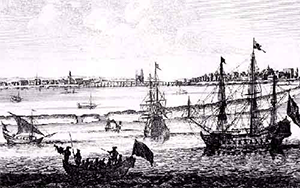The Dutch West India Company
The Dutch West India Company was an umbrella organization for the expansion of trade and influence pursued by the Dutch Republic into the Western Hemisphere in the 17th and 18th Centuries. 
The similarly named Dutch East India Company (VOC) dated to 1602 and focused on economy and trade, not to mention armed defense thereof, in Southeast Asia and in Asian waters. The Dutch Republic, however, wanted a global trade scheme and so pursued avenues of exploration in Africa and in the Americas, including in the Caribbean. Hampering this process to a large degree was the ongoing war with Spain, which dated to 1568. Relations between the two powers were somewhat better during the Twelve Years' Truce, but that ended in 1621 and the Dutch West India Company found life as a means to further Dutch aims in the Western Hemisphere. The States-General had granted the VOC a state-protected monopoly on all Dutch trade; many whose efforts resulted in the creation of the Dutch West India Company wanted to operated outside that monopoly. Following the example of the VOC, the GWC, as the West India Company was known (being an acronym of the Dutch Geoctrooieerde Westindische Compagnie), won a state-encouraged monopoly on trade in North America and in West Africa. As in the east, all cargo from the west went through the motions of the GWC. Of particular interest to the Dutch in these western lands were dyewood, sugar, and tobacco, and of paramount importance in protecting that trade were the colonies of Curaçao, part of the Netherlands Antilles, and Suriname. 
The VOC and GWC both had ships of exploration that also carried weapons of war. Armed men traveled aboard ships and acted as guards against hijacking by foreign powers. As it turned out, having dozens of armed men onboard ship proved valuable for the Dutch as the years progressed, for in the face of overall poor results in efforts to colonize lands in the Western Hemisphere, the Dutch had rather more to show for their troubles when they chose to plunder the cargo of enemy ships. Some estimates put the number of enemy ships plundered by Dutch opportunists at more than 500. Spain, Portugal, and England naturally protested such actions but were largely powerless to react in kind because of military commitments elsewhere. Some exceptions to this Dutch failure to colonize:
Portugal, naturally, didn't take too kindly to such intrusions, and the two powers went to war. Significant Portuguese successes in 1625 resulted in the expulsion of the Dutch from Africa and most of the Americas. Both sides struggled to gain traction during the next few decades, holding on to their trade routes but not achieving much else. A 1661 treaty brought an end to the fighting. The GWC had jumped into the slave trade during the war with Portugal, and this was the most lucrative commodity remaining when the GWC ended, in 1674; even with the money pouring in from the slave trade, the company had larger outstanding debts. The solution, from the States-General, though, was the disestablishment of the existing company and then the creation of a new one, with the same name. With war against Portugal and Spain no longer on the horizon, the new GWC was free to focus on its trade, particularly on the slave trade. Some estimates have the number of slaves shipped from Africa to Dutch colonies in the west at approaching 200,000 in total. That largely stopped by 1740, although it was more of an economic decision than a moral one. The second GWC limped along for the next few decades, then, in 1791, went the way of its predecessor. |
|
Social Studies for Kids
copyright 2002–2025
David White




